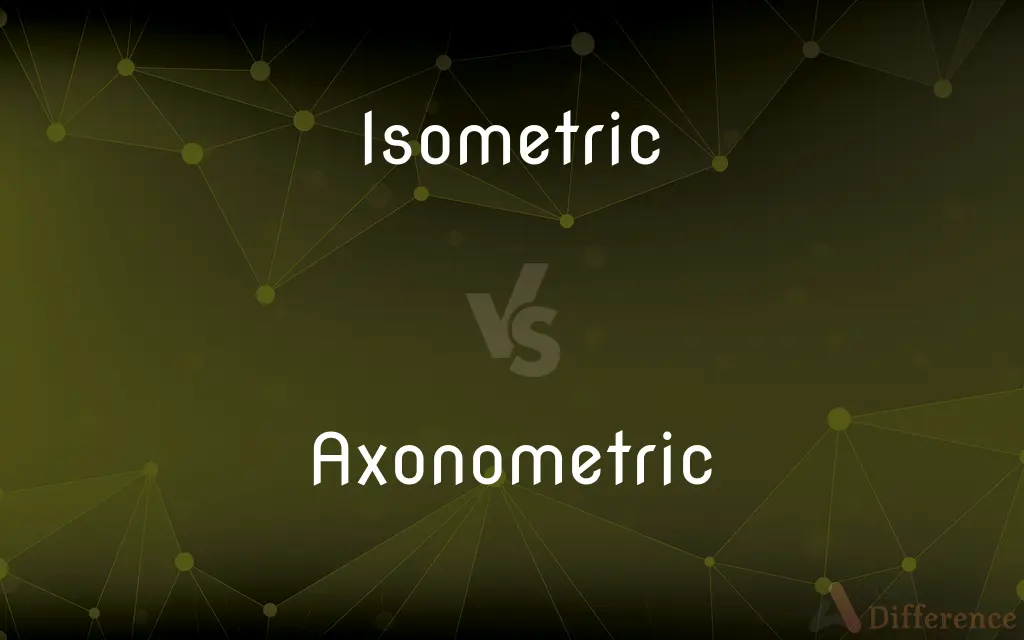Isometric vs. Axonometric — What's the Difference?
By Urooj Arif & Fiza Rafique — Updated on March 12, 2024
Isometric projection showcases objects with equal dimensions, while axonometric includes other angles and scales.

Difference Between Isometric and Axonometric
Table of Contents
ADVERTISEMENT
Key Differences
Isometric projection is a method where the scale along each axis is equal, creating a distortion-free representation of 3D objects on a 2D plane. This technique gives a clear sense of the dimensions and shape of the object, which is particularly useful in technical and engineering drawings. On the other hand, axonometric projection encompasses various types of projections, including isometric, but also dimetric and trimetric projections, which use different scales or angles along one or more of the axes. This variety allows for more flexibility in how the object is represented, catering to the specific needs of a project.
In isometric projection, all angles between the axes are 120 degrees, providing a symmetrical view that is easy to understand and interpret. Whereas axonometric projections can have varying angles between axes, leading to different degrees of distortion. This flexibility can be advantageous for emphasizing certain aspects of a design or for fitting the projection into a specific layout or space.
Isometric drawings simplify the rendering process by avoiding the need to calculate perspective, making it straightforward to create and interpret. This simplicity is especially beneficial in technical fields where clarity and precision are paramount. Axonometric projections, while still avoiding perspective, can introduce varying degrees of complexity depending on the type (dimetric or trimetric), which may offer more descriptive possibilities but at the cost of increased complexity in drawing and interpretation.
Isometric projection is commonly used in engineering, architecture, and video games for its clarity and ease of interpretation. It provides a balanced view of objects, making it ideal for technical documentation and design. Axonometric projection, with its broader range, finds applications in various fields, offering more flexibility in visual representation, which can be particularly useful in artistic and architectural contexts where a different perspective may provide additional insight or aesthetic appeal.
The term "isometric" comes from the Greek for 'equal measure', reflecting the equal scale on all three axes. Axonometric, derived from 'axis' and 'measure', indicates a measurement along the axes but does not imply equality, highlighting the fundamental difference in how these projections approach the depiction of three-dimensional objects.
ADVERTISEMENT
Comparison Chart
Angles between axes
120 degrees
Varies (not fixed)
Scale
Equal on all axes
Can vary on one or more axes
Types
Only one
Includes isometric, dimetric, trimetric
Distortion
None
Can vary
Use Cases
Engineering, architecture, video games
Broader range including artistic and architectural visualization
Compare with Definitions
Isometric
A method of visually representing three-dimensional objects in two dimensions, where all three axes are oriented equally.
An isometric drawing of a cube shows all sides with equal dimensions.
Axonometric
A broader category of projections including isometric, dimetric, and trimetric types, representing 3D objects on 2D planes.
An axonometric drawing of a building might use a dimetric projection for a more dynamic view.
Isometric
Useful for technical drawings due to its clarity and ease of understanding.
Engineers often use isometric projections for part schematics.
Axonometric
Can introduce some distortion, depending on the angle and scale chosen.
A dimetric projection may exaggerate the height of an object for effect.
Isometric
No distortion or perspective is applied, making measurements straightforward.
Measuring a line in an isometric drawing is the same along any axis.
Axonometric
Versatile in application, from technical to artistic fields.
Architects may use axonometric projections to present a more complete understanding of a space.
Isometric
It provides a balanced view, making it easy to visualize complex shapes.
An isometric diagram of a machine part reveals all surfaces without overlap.
Axonometric
Allows for varying scales and angles, offering flexible representations.
In a trimetric projection, each axis can have a different scale, highlighting certain features.
Isometric
Often used in video games and pixel art for its appealing aesthetic and simplicity.
Classic games like SimCity utilize isometric graphics for a clear, detailed view.
Axonometric
The choice of projection type can tailor the visualization to specific needs.
Choosing a trimetric projection can emphasize the depth of a complex object.
Isometric
Of or exhibiting equality in dimensions or measurements.
Axonometric
Of or relating to an orthogonal projection in which distant features are drawn to the same scale as near ones, thus causing some distortion but allowing views of more than one side of the object.
Isometric
Of or being a crystal system of three equal axes lying at right angles to each other.
Axonometric
(technical drawing) Describing a projection in which the horizontal and vertical axes are to the same scale, but the third axis is reduced to allow for perspective
Isometric
(Physiology) Of or involving muscular contraction against resistance in which the length of the muscle remains the same.
Isometric
A line connecting isometric points.
Isometric
Of, or exhibiting equality in dimensions.
Isometric
Of, or being a geometric system of three equal axes lying at right angles to each other (especially in crystallography).
Isometric
(physiology) Of or involving muscular contraction against resistance in which the length of the muscle remains the same. See also: Wikipedia:isometric exercise
Antonyms include tonic movements auxotonic and isotonic which are divided into concentric and eccentric.
Isometric
Taking place at constant volume because of being confined by rigid boundaries.
Isometric
A line connecting isometric points.
Isometric
Pertaining to, or characterized by, equality of measure.
Isometric
Noting, or conforming to, that system of crystallization in which the three axes are of equal length and at right angles to each other; monometric; regular; cubic. Cf. Crystallization.
Isometric
Of or pertaining to isometrics.
Isometric
A line connecting isometric points
Isometric
Related by an isometry
Isometric
Of or involving muscular contraction in which tension increases while length remains constant
Isometric
Having equal dimensions or measurements
Isometric
Of a crystal system characterized by three equal axes at right angles
Common Curiosities
Can axonometric projection introduce distortion?
Yes, depending on the angles and scales used, axonometric projections can introduce some distortion.
What is axonometric projection?
Axonometric projection is a broader category that includes isometric, dimetric, and trimetric projections, allowing for varied angles and scales.
What is isometric projection?
Isometric projection is a method of drawing a 3D object in 2D, where all three axes have equal angles and scale.
How do isometric and axonometric projections differ in use?
Isometric is commonly used for clarity and precision in technical fields, while axonometric offers more flexibility for various applications.
What is a dimetric projection?
A type of axonometric projection where two axes have the same scale but differ from the third, creating a unique perspective.
Why is isometric projection popular in video games?
Its clarity, simplicity, and lack of distortion make it appealing for both design and aesthetic purposes in games.
How do angles in isometric and axonometric projections compare?
Isometric projections use fixed 120-degree angles between axes, while axonometric angles can vary.
Are measurements in isometric drawings accurate?
Yes, measurements can be accurately represented due to the equal scale on all axes.
What is a trimetric projection?
Trimetric projection uses different scales and angles for all three axes, offering a highly flexible representation.
Does isometric projection work well for all types of designs?
While versatile, its lack of perspective might limit its use in depicting highly detailed or specific viewpoints.
What makes axonometric projection flexible?
Its ability to vary scales and angles allows for tailored visual representations.
Is isometric drawing easy to learn?
Yes, its rules and lack of perspective make it relatively straightforward to master.
Can axonometric projections be used in art?
Absolutely, their flexibility makes them suitable for artistic and architectural visualization.
Why might an architect choose axonometric projection?
For its ability to offer different perspectives, making designs more comprehensible or visually appealing.
Are there software tools specifically for isometric drawing?
Yes, many CAD and graphic design tools have features or modes dedicated to isometric drawing for precision and ease.
Share Your Discovery

Previous Comparison
Refilling vs. Stock
Next Comparison
Inscribe vs. EngraveAuthor Spotlight
Written by
Urooj ArifUrooj is a skilled content writer at Ask Difference, known for her exceptional ability to simplify complex topics into engaging and informative content. With a passion for research and a flair for clear, concise writing, she consistently delivers articles that resonate with our diverse audience.
Co-written by
Fiza RafiqueFiza Rafique is a skilled content writer at AskDifference.com, where she meticulously refines and enhances written pieces. Drawing from her vast editorial expertise, Fiza ensures clarity, accuracy, and precision in every article. Passionate about language, she continually seeks to elevate the quality of content for readers worldwide.













































